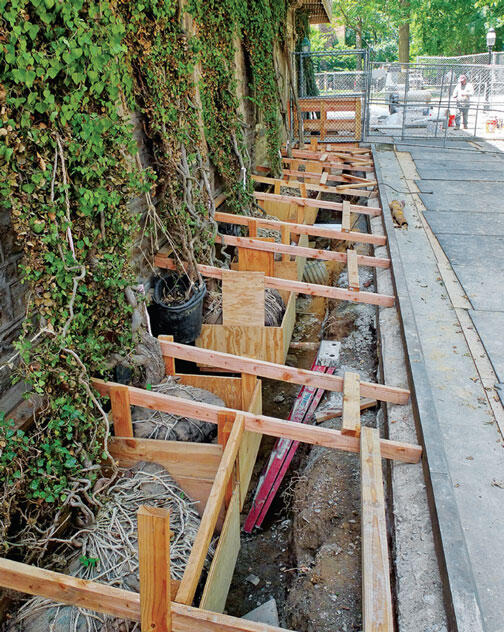For some members of our University community, September marks the end of the “lazy days of summer,” but for Vice President for Facilities Mike McKay and his staff, the beginning of the academic year is actually a respite. For 12 hectic weeks, sandwiched between Commencement and Labor Day, scores of staff and contractors, engaged in a host of small but important projects, take advantage of the absence of our faculty and students and fan out across the campus to renew its infrastructure and refresh its landscape. And with 180 buildings and 500 acres to care for, they have their hands full!
This work does not command the attention of projects like the construction of the Andlinger Center for Energy and the Environment or the installation of 16,500 photovoltaic panels on University lands, designed to reduce our dependence on fossil fuels. No ribbons are cut upon completion, but without such quiet tending, Princeton would cease to be a worldclass institution. From repointing masonry to repairing steam tunnels; from renovating laboratories to upgrading serveries, Facilities exercises the kind of stewardship that a great University both requires and deserves.
For this we have four things to thank. The first is sufficient resources to care for our campus well, minimizing deferred maintenance and meeting emergencies when they arise — a credit to the generosity of our alumni and the foresight of our trustees. The second is a sophisticated rolling 10-year plan that forecasts what will need attention when, while allowing for the unexpected. The third advantage we enjoy is the exceptional dedication of our staff, who treat the grounds and buildings in their care as if they were their own. Many have worked at Princeton for decades, which means they know each natural and manmade feature of our campus intimately, exemplified by electrician Renato Carazzai, who joined our staff in the fall of 1958 and is still going strong. Finally — and most importantly — the projects carried out each summer reflect a long and widely held belief that we must both actively preserve our material heritage and continually adapt it to changing circumstances; that Princeton can no more rest on its physical laurels than on its intellectual ones. The net result is a campus that positively shines, greatly enhancing the experience of Princetonians and visitors alike.
Let me give you just two examples of the work we undertook this summer. One deceptively prosaic task was to waterproof the eastern foundations of West College, built in 1836 — a project driven by the Office of Admission’s move from a paper-based to an electronic evaluation process for the more than 25,000 applications it now receives each year. To accommodate the computers and scanners at the center of this far-reaching change, West College’s floodprone basement had to be reconfigured on the inside and sealed on the outside, all in a few months. Unfortunately, excavating the basement walls threatened a feature of the building that was just as fragile — and certainly more loved — than the equipment we were trying to protect. I am referring to its beautiful expanse of ivy, which, if uprooted, could take as much as half a century to grow back. Faced with this conundrum, Grounds and Building Maintenance mobilized their ingenuity. A set of wooden boxes was constructed, and the ivy’s root balls — carefully wrapped in burlap — were suspended in them until the project was completed, right on time to welcome the Class of 2016.
The delicate balancing of old and new also distinguished a project to update the technology in McCosh 50, Princeton’s largest lecture hall and one of its most storied. It was in this room, for example, that Albert Einstein delivered five lectures on relativity during his first visit to the United States in 1921. Of course, in the past 90 years, technology has done its own part to alter conceptions of space and time, and this summer, our Office of Design and Construction and Office of Information Technology joined forces to bring McCosh 50 into the 21st century while maintaining its historic ambience. The blackboards remain, but discreetly housed in the podium is one of Princeton’s first forays into the world of SMART technology — a tablet that allows lecturers to annotate material projected on the screen behind them and, ultimately, on any computer with an Internet connection through what is aptly known as Bridgit conferencing. Similarly, McCosh 50 is now equipped with high-definition television cameras and other technologies that will enable or enhance recordings, simulcasts, videoconferencing, and distance learning — part of a larger effort to share what happens in our classrooms with a worldwide audience. Other spaces have also been upgraded, and faculty and student reaction to these technological innovations will help determine the future shape of teaching at our University.
A wide range of other projects left their imprint on our campus this summer. Some, such as the substitution of electronic for mechanical dormitory room locks, will be apparent when you return for Reunions; others, such as the regrading of Little-Edwards courtyard, are more subtle. But, obvious or not, those who carried out these projects are the unsung heroes of a new academic year, which, like so many before it, is reaping the fruits of their hard work.














No responses yet